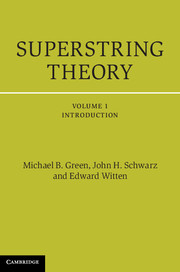4 - World-sheet super symmetry in string theory
Published online by Cambridge University Press: 05 September 2012
Summary
The bosonic string theory described in chapters 2 and 3, despite all its beautiful features, has a number of shortcomings. The most obvious of these are the absence of fermions and the presence of tachyons. It is conceivable that the latter feature merely indicates that the vacuum has been incorrectly identified, and that (as in a Higgs theory) there is some other stable vacuum that does not give rise to tachyons. Despite considerable effort over the years, this remains a conjecture. Another route, which has proved more fruitful, is to try to formulate another string theory instead. Progress in this direction has involved the introduction of internal degrees of freedom propagating along the string.
The particular string theory described in this chapter is based on the introduction of a world-sheet supersymmetry that relates the space-time coordinates Xμ(σ, τ) to fermionic partners ψμ(σ, τ). The latter are twocomponent world-sheet spinors. We will demonstrate that an action principle with N = 1 supersymmetry gives rise to a consistent string theory with critical dimension D = 10. Truncating the spectrum in a manner proposed by Gliozzi, Scherk and Olive gives supersymmetry in the D = 10 space-time sense, as well, with one or two Majorana-Weyl supercharges (N = 1 or N = 2) depending on the choice of boundary conditions.
In view of the enormously rich and fascinating structure that results from the introduction of N = 1 world-sheet supersymmetry, it is natural to consider generalizations based on extended supersymmetry.
- Type
- Chapter
- Information
- Superstring Theory25th Anniversary Edition, pp. 185 - 248Publisher: Cambridge University PressPrint publication year: 2012



